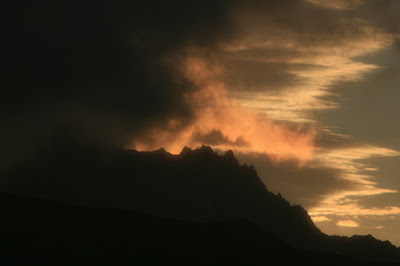
We pull the skiff in here when visiting town.

False Pass is a village of about 30 people. We have met (we just counted) 7 people not including a few cars that have passed us and one boy playing in the mud puddles. Everyone is very friendly and helpful. Even the boy gave us a wave. Bob has noticed some changes in since his last stay. There is a new post office, a grocery and a liquor store. They are building a harbor and a processing plant on the north end. He seems to think that town has spread out a bit. People are hopeful that the new additions will bring more opportunity and new people to village.
Harbor construction


It's just a ten minute walk to the post office, usually our reason for coming across the water. We are always greeted and chaperoned by this dog, whose name we cannot remember. He likes to attack Bob's boots. The farther one, is very alpha, and did not like Inde at all. For this reason we leave Inde at home.

Looking down the main boardwalk on the Peter Pan Seafoods grounds. Upon it's establishment in 1920, locals from nearby villages, now abandoned, began relocating to False Pass. Cannery buildings from Morzhovoe Village, on the peninsula, were towed to False Pass. For the next 61 years the cannery was the primary economic driver in the village, that is until March 6th, 1981 when it burned to the ground. It still provides indoor storage space, fuels, loading, a mess hall, and lodging.

I must admit this was an exceptional day for mail. Packages are so much fun, even if they are just computer stuff for Bob.


































